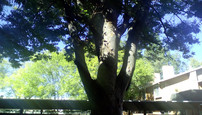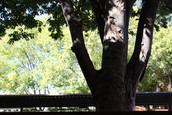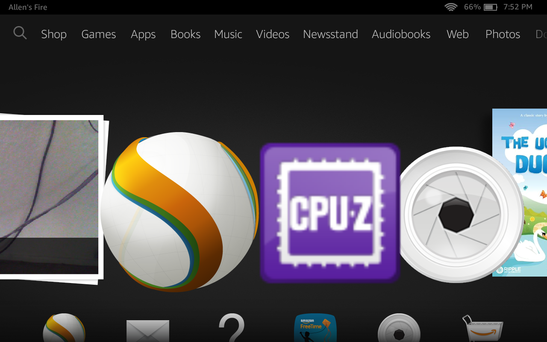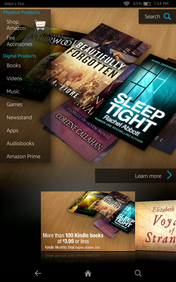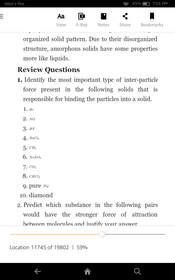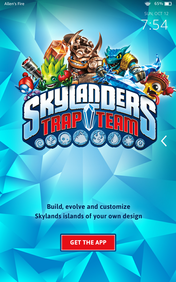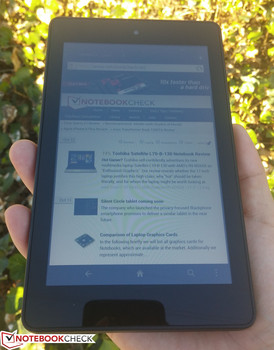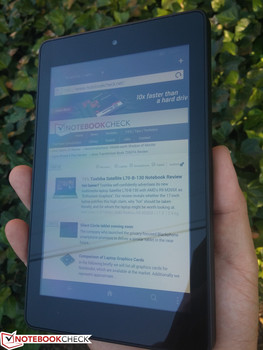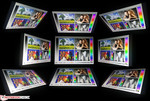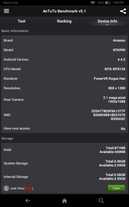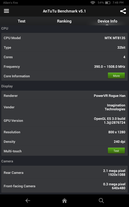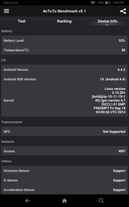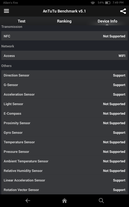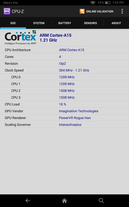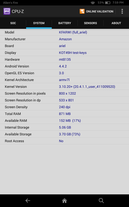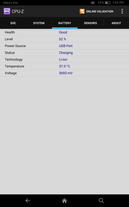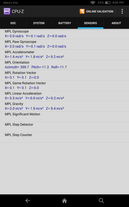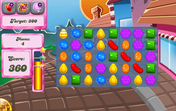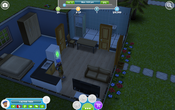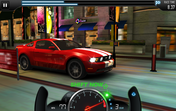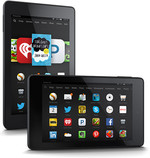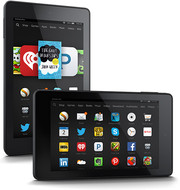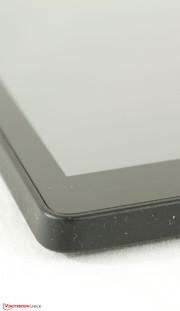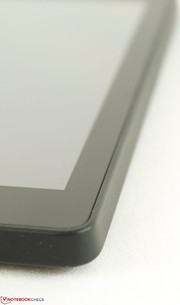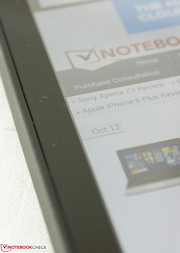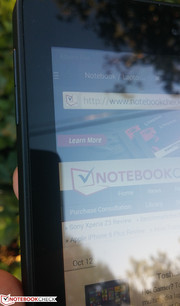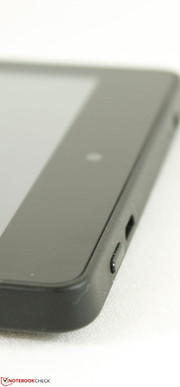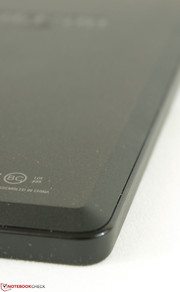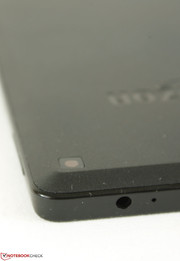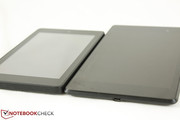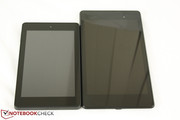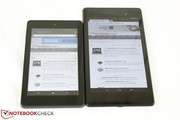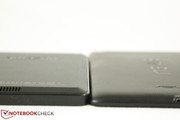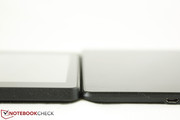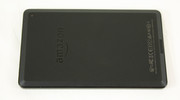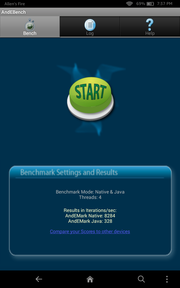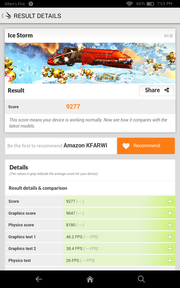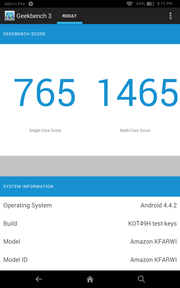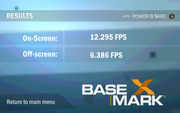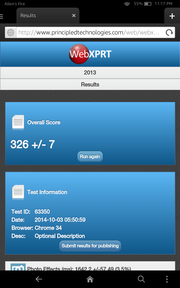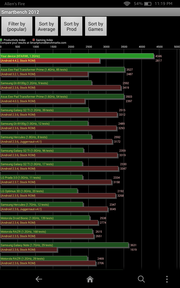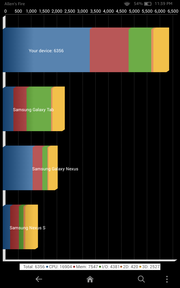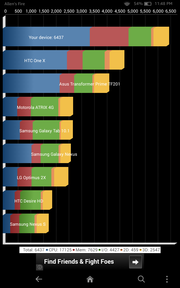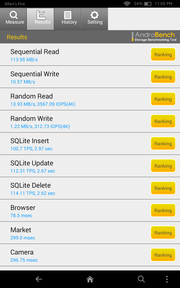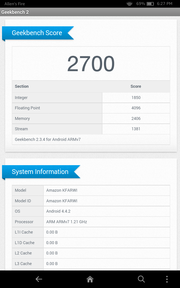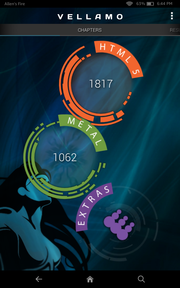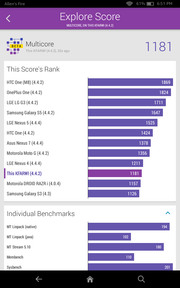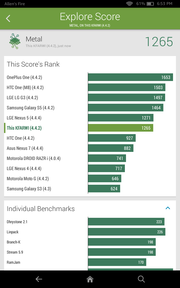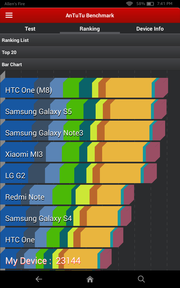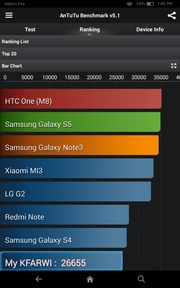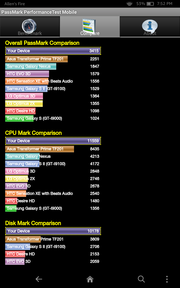Amazon Kindle Fire HD 6 Tablet Review
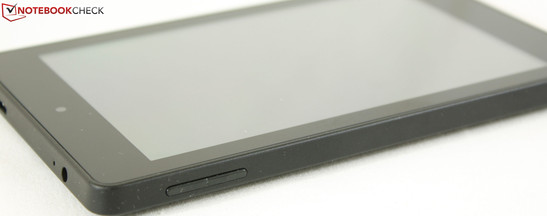
Amazon’s annual rerelease of their successful Kindle Fire series continues this year with a slew of new tablets ranging from 6-inches to 8.9-inches. While the 7-inch and 8.9-inch models are more or less refreshes of previous models, the 6-inch model is a new category for the series. Taking into account its low starting price of under $100, this tablet echoes the original 7-inch Kindle Fire in offering a functional and affordable tablet that undercuts most competing models of the same size.
Aside from the Fire Phone, the Fire HD 6 is the smallest model in the family and sports very respectable hardware considering the price. Core features like the 1280 x 800 IPS display and plastic chassis both look and feel sturdy and impressive for the size. Of course, corners had to be cut in order to meet the low price point and some omitted features may disappoint certain buyers in the long run. In this review, we compare the Fire HD 6 with other models in its size class and see if its hardware can go toe-to-toe with more expensive competitors. Is this inexpensive $99 Amazon tablet worth your time?
Case
The original Kindle Fire launched in late 2011 with one of the thickest chassis around at just over 11 mm. While subsequent revisions thinned down the profile, case quality suffered as a result. The Fire HD 6 hearkens back to the original with a thick profile (10. 7 mm) while keeping some of the better aesthetic qualities of the latter models to retain a strong chassis without sacrificing looks. The model feels great in the hand no matter the orientation and actually feels easier to grip than its 7-inch HDX counterpart. The matte plastic back and glass front warp very little under pressure with only very minor signs of creaking and twists. The rubberized surface of the original Kindle Fire is completely gone and replaced with smooth plastic all-around. The texture is very slightly bumpy, which reduces fingerprint buildup quite well.
Perhaps surprisingly, all these features add up to a chassis that can hold its own against other similarly-sized tablets. By allowing for a thicker design, Amazon have managed to outclass their thinner competitors in case quality and sturdiness. Competing 6-inch models like the HP Slate 6 and Nokia Lumia 1320 may be better aesthetically, but the Fire HD 6 will be the one that can take the daily abuse and still live to tell the story.
In terms of weight, the Fire HD 6 is a bit heavier than other 6-inch devices as expected from its wider girth and thick bezel. For example, the Slate 6 and Liquid S2 weigh 160 and 231 grams, respectively, compared to almost 300 grams of the Fire HD 6. Though the figures are small, they are certainly noticeable on such small tablets. There is no denying that the Amazon tablet has a heft to it that gives it its rigid feel, but at the same it is understandable that some users may prefer a thinner, lighter, and more eye-catching chassis at the cost of structural integrity.
Connectivity
Like other members in the Fire family, the HD 6 is severely lacking in connectivity options. Basics such as 3.5 mm audio and microUSB ports are available, but anything more would be asking for too much from a very inexpensive tablet. In its defense, however, competing models do not offer much beyond these basics either, though a few models like the Lumia 1520 or Galaxy Note II have microSD and SIM slots for better expandability and versatility.
Attempting to connect external devices like generic keyboards and mice via microUSB will work natively on the Fire HD 6. While typing feels quick and responsive, the onscreen mouse cursor has a notable latency compared to a desktop cursor, so scrolling and clicking can be frustratingly slow at times. On the other hand, USB flash drives will work if they are formatted in FAT as our tested NTFS drive could not be natively recognized by the tablet. MHL is also not supported as our tested connection to an external monitor proved fruitless.
Communication
Wireless connectivity includes single-band WLAN up to wireless-n and Bluetooth for A2DP headphone support. Location-based services are provided through WiFi, but there are no dedicated GPS receivers or WWAN antenna for connectivity outside of WLAN range. This makes the tablet less attractive to users who are constantly roaming where reliable WLAN is unlikely. As for wireless external support like Miracast, users will be out of luck here as well.
Accessories
The Fire models are made to be stand-alone devices with no need for dedicated accessories, attachments or docking stations. Thus, accessories for the Fire HD 6 are limited to generic cases and compatible USB devices. Official screen protectors and stands are currently offered by Amazon.
Warranty
Amazon provides the standard 1-year limited warranty with the option to extend up to three years for an additional $40. Note that the extension is available only for U.S. customers for now with no announcements for buyers elsewhere.
Cameras
Whereas the HDX 7 launched with only a front-facing camera, the HD 6 includes both rear and front-facing cameras. The catch, however, is that the front-facing camera is now VGA (640 x 480) vs. 1.2 MP on the HDX 7, while the rear camera is only 2 MP compared to 5 MP or higher on most other tablets.
Pictures from the rear-facing camera are blurry, even under optimum lighting conditions and using the tap-to-focus feature. Recorded 1080p videos suffer from the same problem as well despite the smooth motion when panning. On the other hand, colors appear accurate with little noise and only a bit of purple fringing is noticeable around darker edges and corners. Images are slightly overexposed too, though this is common on tablets such as the Slate 6.
Performance under low light conditions are much worse as noise quickly becomes a problem. The standard camera app offers little options outside of HDR and panorama to aid in picture-taking.
Software
The unique Amazon Fire UI has evolved little since its inception on the original Kindle Fire. The current Fire OS 4.1.1 iteration is based on Android KitKat 4.4.2 and the Carousel continues to be the center of the homescreen interface. While this is efficient for a small number of apps and ebooks, the Carousel can quickly become convoluted and unorganized if the user frequently opens a multitude of applications. Fortunately, Amazon has alleviated the problem by including a more traditional homescreen option with the familiar grid of customizable app icons. It’s a step in the right direction, but customization is still far below what Android and even iOS devices can offer.
The smaller screen size has a slight negative effect on navigation as the top row of options including “Shop”, “Games”, “Apps” and “Books” are on the small side. Some of these options simply take the user to a different section of the Amazon App Store, so there is a clear redundancy of certain features and icons on the homescreen - likely as an attempt to encourage users to purchase digital products from the Amazon marketplace.
Speaking of apps, Android apps from the Play Store are not officially supported, but they can continue to be sideloaded onto the device as Fire OS is a fork of Android. These applications are not guaranteed to run or even launch properly on the Fire HD 6, so users may be disappointed to find that the Amazon device can be incompatible with their favorite applications. In fact, a few of our Play Market benchmark applications are unable to launch at all including Epic Citadel, Anomaly 2, and Basemark X 1.1. Some browser-based benchmarks like Browsermark 2.1, Peacekeeper, and Octane V2 are also incompatible with the Silk browser at the time of review.
As for the Reader itself, ebook features include the usual font size, text options, bookmarks, and search functions. Amazon have also been touting their X-Ray feature, which allows readers to quickly look up characters and definitions of the current ebook without referring to online sources. Not all ebooks support X-Ray, but the feature does make it very easy to reference relevant keywords all within the Reader app. It's a useful tool especially for younger readers who may be more likely to look up words and characters for a better understanding.
Input Devices & Handling
Touchscreen
The multi-touch capacitive touchscreen responds to inputs with no major issues. The smaller screen size, however, does make certain icons smaller and thus more difficult to tap. The Home, Back and Search buttons, for example, are easy to miss with no options to increase the size of the icons. Furthermore, the lack of any haptic feedback makes it more difficult to really see if your inputs have been registered. Ideally, the display should respond to your inputs immediately, but the Fire HD 6 suffers from the occasional lag and delayed loading screens that will make you question whether or not your last input was accurate.
Fortunately, the onscreen keyboard does not suffer from any of the latency issues mentioned above. Letters and numbers appear without delay and Swype is enabled by default for those who prefer it. We find touch-typing to more comfortable on the 6-inch display as opposed to smaller or larger devices where keys can feel too cramped or far away from the thumbs.
As for any physical buttons, there are only the basic Power button and Volume rocker. While the Power button is easy to depress with firm feedback, the volume buttons are too flushed on the edge and can be difficult to reliably hit, especially with larger fingers.
Display
The Fire HD 6 shares the same resolution as its larger Kindle Fire HD 7 sibling of 1280 x 800 pixels. Its resulting 252 PPI is thus more dense than many 7-inch tablets where 800p is standard, such as on the original Google Nexus 7, Dell Venue 7 and Asus Fonepad 7. Subjectively, images and text are sharp on the glass-covered 6-inch display, even when zoomed out to fit the screen. Our standard Notebookcheck review pages, for example, are typically very text heavy, but the pages are at a comfortable viewing level without needing a higher magnification.
Our average measured screen brightness of nearly 400 nits is very high for such an inexpensive device. In fact, this is brighter than a good handful competing 6-inch to 8-inch tablets including the Lenovo Tab A8 and Acer Iconia Tab A8. Nonetheless, the 2013 Nexus 7, Acer Liquid S2, and Nokia Lumia 1320 tablets are a step brighter than the Amazon in review. A strong backlight is invaluable for outdoor usability and reading, so it is a relief to see that the manufacturer has chosen not to cut any corners in this regard. Coincidentally, its contrast level is just as impressive for excellent movie playback.
| |||||||||||||||||||||||||
Brightness Distribution: 86 %
Center on Battery: 407.9 cd/m²
Contrast: 727:1 (Black: 0.561 cd/m²)
ΔE ColorChecker Calman: 4.44 | ∀{0.5-29.43 Ø4.78}
ΔE Greyscale Calman: 3.66 | ∀{0.09-98 Ø5}
Gamma: 1.99
CCT: 6404 K
Further analyses with an X-Rite spectrophotometer reveal accurate and consistent colors across the board on all saturation levels. Again, this is unexpected considering the bargain price point of the Fire HD 6 as it rivals many costlier devices. Even so, onscreen colors and text do not pop as much as on other devices because the screen itself is underneath thicker layers of glass and other material. An iPad, for example, has its screen very close to the surface of the device, whereas the screen on the Fire HD 6 appears more buried and farther away from the user.
One feature of last year's HDX 7 was the tablet's blue backlight LEDs, which Amazon claimed could provide more accurate colors versus standard white backlights. The move backfired as users began noticing a somewhat distracting blue glow around the edges of the tablet during use as a direct consequence. For the Fire HD 6, the manufacturer had either dropped their blue backlight altogether or solved the issue entirely as we have noticed no such issues on our 6-inch device. There is a small amount of backlight bleeding to be sure, but certainly nothing distracting during everyday use.
Outdoor usability is possible due to the high screen brightness. The maximum setting is recommended in order to overcome both ambient light and glare on the reflective screen. Visibility is greatly impaired under direct sunlight, of course, but the device is still relatively usable for long periods assuming higher zoom levels for text. This is especially true when reading ebooks where larger font sizes can potentially reduce eyesore.
Note that there is no ambient light sensor; its omission is likely for reducing costs in order to meet the target price point.
Viewing angles are wide and stable thanks to the underlying IPS panel. This ultimately makes the tablet usable in any orientation and can be easily shared with others nearby. Viewing from extreme angles will incur a slight drop in brightness, so it may not be a bad idea to have a higher backlight setting if sharing the device with others.
Performance
Kindle Fire hardware specifications are not explicitly advertised in detail as Amazon would rather focus on unique software features of the models to separate them from typical Android or iOS devices. Additionally, because of the low cost of the Fire HD 6, internal hardware is not expected to have mind-blowing performance.
The 6-inch Amazon is equipped with a MediaTek MTK8135 quad-core processor consisting of two pairs of cores clocked at 1.5 GHz and 1.2 GHz, respectively. The processor is rated for a maximum of 1.7 GHz, but it never quite reaches that speed in the Kindle Fire 6 according to CPU-Z, likely due to power conservation and heat reduction. Its asymmetric clock speeds are also a power-saving feature in a manner similar to Samsung's big.LITTLE technology in their Exynos SoCs. As for RAM, only 1 GB is available.
Since the Fire HD 6 is the first model in our database to carry the MediaTek MTK8135, we have no other models with the same SoC to compare to. However, we can still provide benchmark comparisons against other devices of similar size as shown below.
General performance according to LinPack, Quadrant, and SmartBench is roughly comparable to the Nexus 7 2013, if not slightly slower. While this sounds promising, this unfortunately does not translate to good performance as detailed in the next section.
| Geekbench 3 | |
| 32 Bit Multi-Core Score (sort by value) | |
| Amazon Kindle Fire HD 6 | |
| HP Slate 6 6000en VoiceTab | |
| Amazon Kindle Fire HDX 7 inch | |
| Acer Liquid S2 | |
| 32 Bit Single-Core Score (sort by value) | |
| Amazon Kindle Fire HD 6 | |
| HP Slate 6 6000en VoiceTab | |
| Amazon Kindle Fire HDX 7 inch | |
| Acer Liquid S2 | |
| Google V8 Ver. 7 - Google V8 Ver. 7 Score (sort by value) | |
| Amazon Kindle Fire HD 6 | |
| Amazon Kindle Fire HDX 7 inch | |
| Google Nexus 7 2013 | |
| Nokia Lumia 1320 | |
| Acer Liquid S2 | |
| Samsung Galaxy Note II GT-N7100 | |
| Vellamo 3.x | |
| Metal (sort by value) | |
| Amazon Kindle Fire HD 6 | |
| Acer Liquid S2 | |
| Multicore Beta (sort by value) | |
| Amazon Kindle Fire HD 6 | |
| Acer Liquid S2 | |
| Browser (sort by value) | |
| Acer Liquid S2 | |
| Acer Liquid S2 | |
| Quadrant Standard Edition 2.0 - --- (sort by value) | |
| Amazon Kindle Fire HD 6 | |
| Amazon Kindle Fire HDX 7 inch | |
| Google Nexus 7 2013 | |
| Acer Liquid S2 | |
| Samsung Galaxy Note II GT-N7100 | |
System Performance
Despite having decent raw performance according to the benchmarks above, subjective performance is on the slow side during even mundane tasks like switching between apps, alternating between tabs, or invoking the keyboard for inputting commands. As mentioned earlier, most taps and touch inputs in general have a slight but noticeable delay before seeing an onscreen response. In fact, pressing the Home button to exit an app will at times greet the user with an unsightly loading screen before the Carousel becomes available. Scrolling through longer or image-heavy webpages will often cause stutters and unloaded portions of the page. The effects are minimized if only one tab or app is open, but even light multitasking can cause the system to slowdown.
This isn't to say that system performance is unbearably slow, but users who are accustomed to faster and more costlier tablets like the Nexus 7 or iPad will notice that the Fire HD 6 lacks the instant response that many other popular tablets offer. This is made more disappointing after experiencing lightning-fast performance from the Snapdragon 800 SoC found in last year's HDX 7. Simply put, this 6-inch tablet could have benefited from a more powerful processor.
1080p video performance is good with support for MP4 and MKV playback without the need for third party apps. Sounds from MKV files may not play correctly, however, and our tested AVI, OGG, and MOV files resulted in playback errors or were simply not recognized by the device.
| Mozilla Kraken 1.0 - Total (sort by value) | |
| Amazon Kindle Fire HD 6 | |
| Amazon Kindle Fire HDX 7 inch | |
| Acer Liquid S2 | |
| Google Nexus 7 2013 | |
| Nokia Lumia 1320 | |
| Mozilla Kraken 1.1 - Total (sort by value) | |
| Amazon Kindle Fire HD 6 | |
| Amazon Kindle Fire HDX 7 inch | |
| Acer Liquid S2 | |
| Nokia Lumia 1320 | |
| HP Slate 6 6000en VoiceTab | |
* ... smaller is better
Storage Devices
Local storage is limited to an 8 GB internal SSD of which only about 4.5 GB is immediately available to the user. This is enough for a good handful of music and apps, but anything more will be stretching the limit. A 16 GB Fire HD 6 model is available for $20 more, which may be appealing to users expecting to hold more movies and other multimedia files. However, there are no SD or microSD readers on either model.
The low capacity is not only due to the bargain starting price of the tablet, but also due to Amazon's push on their Cloud services. The provider offers "free, unlimited cloud storage for all Amazon content and photos taken with your Fire devices" and also up to 250 user-imported songs at no additional cost. As for all other non-Amazon files and apps, users are given 5 GB of storage on the Cloud Drive.
Though the Cloud Services are a great incentive, we stress that they become useless if not connected to a WiFi network. For a WiFi-only device, this limits the versatility of the Fire HD 6 as a multimedia tablet for music and movie playback on-the-go.
Gaming Performance
According to 3DMark 2013 Ice Storm, the integrated PowerVR G6200 is roughly on par with the more common Nvidia Tegra 4 and outperforms the SGX544MP2 found in many Android devices. Thus, users should expect to be able to play any of today's made-for-tablet games without significant issues. Light titles like Angry Birds or Candy Crush will run just fine, of course, but we also tested Sims and CSR Racing, both of which play smoothly with decent - albeit heavily aliased - graphics.
Do keep in mind that many of the 3D titles in the Amazon market can be several hundred megabytes in size or more and can quickly occupy the small internal SSD. The games selection is also much more limited compared to what users can find in the Android or iOS markets. Sideloading 3D Android games onto the Kindle is very hit-or-miss as well.
| 3DMark Ice Storm Standard Score | 9277 points | |
Help | ||
Emissions
Temperature
When idling, surfing the web or watching a movie, the Amazon tablet will barely warm up. Surface temperatures average around 33 degrees C on both sides with no noticeable hot spots. Unless if your tablet happens to have a Core i5 or i7 CPU, this uniformity in surface temperature is common under low loads.
To simulate stressful conditions for maximum load temperature, we ran Stability Test 2.5 for just over an hour before taking readings. This is unrepresentative of real-world usage, but it gives a good contrast to our low-power idling state. Under these conditions, we were able to measure surface temperatures of almost 50 degrees C concentrated on the side of the tablet with the Power button, which happens to be where the logic board and processors are located. This is much warmer than competing tablets where 40 degrees C is more common under similar testing conditions, such as the Liquid S2 and Slate 6. Though users will almost never experience temperatures as high as our recordings under normal use, extended periods of multitasking, tabbed browsing, or playing games will certainly cause a noticeable temperature gradient on the device.
(-) The maximum temperature on the upper side is 45.2 °C / 113 F, compared to the average of 33.7 °C / 93 F, ranging from 20.7 to 53.2 °C for the class Tablet.
(-) The bottom heats up to a maximum of 49.6 °C / 121 F, compared to the average of 33.2 °C / 92 F
(±) In idle usage, the average temperature for the upper side is 32 °C / 90 F, compared to the device average of 30 °C / 86 F.
Speakers
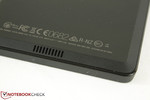
Unlike its larger siblings with dual stereo speakers, the Fire HD 6 is limited to a single monaural speaker. The speaker grilles are on the back side of the tablet opposite to the edge where the rear camera is situated.
Sound quality is good for such a small device with respectable bass and balance. However, since the grilles are facing away from the user, sounds are muffled and maximum volume feels quite low. Furthermore, sounds will be heavily biased towards one end of the tablet, which means that one ear will be hearing a louder volume than the other when in landscape mode. While this is fine for the occasional video, external 3.5 mm solutions are recommended for extended sessions and music playback.
Battery Life
The non-removable 3400 mAh internal Li-ion polymer battery is expectedly much smaller than the 45 Wh battery in the larger Kindle Fire HDX 7. When compared to other 6-inch devices, however, the Fire HD 6 carries a similarly sized battery pack. The Slate 6, Liquid S2, Lumia 1320, and Galaxy Note II have 3000, 3300, 3400, and 3100 mAh battery packs, respectively.
Sitting completely idle at the lowest brightness setting will result in a runtime of over 15 hours, while running Stability Test 2.5 at maximum screen brightness will result in a runtime of almost 3 hours. Our standard WiFi surfing script at a screen brightness of 150 nits results in almost 10 hours of runtime, which is more or less on par with the 6-inch devices mentioned above. The Liquid S2 can last for 14 hours under similar testing conditions, though this Acer model is also much more expensive than the Fire HD 6 in review. For everyday WLAN use, we feel that 8 to 10 hours of continuous usage should be plenty before needing to recharge by the end of the day.
Verdict
The original Kindle Fire made a splash in the tablet market by offering both respectable hardware and decent performance for what was a bargain price back in 2011. Three years later and Amazon have done it again with the Kindle Fire HD 6 despite the increasingly crowded tablet market.
The manufacturer deserves praise for a handful of aspects that rival more costly phablets in the market. Namely, chassis quality, screen brightness, display quality, and battery life are all better than expected for the low price of $99. It's clear that Amazon have cleverly focused on the core features considering the very limited manufacturing costs.
Of course, corners had to be cut, and in this case they include expandability and many multimedia features. NFC, MHL, WWAN, SIM, microSD, GPS, stereo sound, haptic feedback, ambient light sensor, and a decent SSD size are some major omissions that immediately come to mind. Additionally, system performance is only average at best as the OS will occasionally stutter when surfing the web or switching between apps.
Like all other Kindle Fire devices, the Fire HD 6 is ultimately designed to sell you digital Amazon products. For those who have no passing interest in utilizing Amazon services, an alternative Android tablet may be the better and more versatile long term solution. With that said, we can't deny the attractive sub $100 price point, and anyone wanting a very basic, inexpensive, and replaceable tablet for the family need not look any further.








